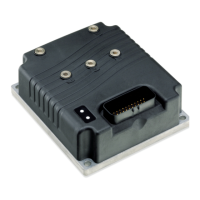92
Curtis 1222 Manual, os 15
2 9 J A N U A R Y 2 0 1 3 D R A F T
The Error Time must be set long enough for the steered wheel to reverse
direction and get to the minimum speed under the worst case conditions. This
may be measured in the field by moving the steer input command rapidly one
direction and then the other. This should achieve the maximum speed in one
direction followed by a reversal and acceleration past the
Speed Tolerance (deg/s)
in the other direction. This time, doubled to provide a safety factor, should be
used for the
Error Time. With appropriate tuning, most applications should be
able to use an
Error Time of 0.5 – 0.8 seconds.
To test the following-error parameter settings, steer under worst case
conditions (maximum weight on vehicle, rough floor, new tire) as follows:
a) Steer in one direction and then reverse and steer at an angle at
least equal to the
Error Tolerance (deg). Then reverse (quickly!) and
steer back at an angle at least equal to the
Error Tolerance (deg) then
reverse (quickly!) and steer back at an angle at least equal to the
Error Tolerance (deg). Continue doing this back and forth until a
Following Error is triggered.
b) Steer, always as quickly as possible, from end stop to end stop,
back and forth, until a Following Error is triggered.
While steering using these two procedures, slowly lower the
Error Time until a
Following Error is triggered.
Finally, verify that the original proposed setting of
Error Time is a comfort-
able margin above the setting that began to trigger the fault. If a comfortable
margin is not provided with the original proposed setting, increase the
Error Time
until a comfortable margin is obtained—but also verify that the
Error Time is not
too slow, which will create a delay in detection a real following error.
bm
Set the remaining Supervision parameters
If Position Feedback Device = 1, leave the setting Supervision » Encoder Position Toler-
ance = 90°. This fault check is not used when the position feedback devices are
encoders, so the setting of 90° disables this fault check.
For all other settings of
Position Feedback Device (= 0 or = 2), observe the vari-
able Monitor
» Supervision » Encoder Position Error (deg) while changing the position;
this will show the difference between Wheel Position and Encoder 3 Position.
Find the maximum
Encoder Position Error (deg), and set Supervision » Encoder
Position Tolerance to provide a comfortable margin above the maximum Encoder
Position Error (deg)
found.
Set Supervision
» Stall Steering Speed and Stall Timeout to appropriate values that
will not cause a fault during normal operation, but will trigger a fault during
a real stall condition.
5 — COMMISSIONING

